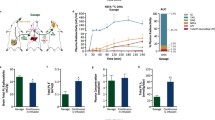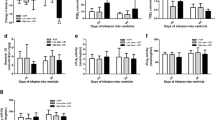Abstract
Transient cerebral ischemia (5 min) releases unesterified fatty acids from membrane phospholipids, increasing brain concentrations of fatty acids for up to 1 h following reperfusion. To understand the reported anti-ischemic effect ofGinkgo biloba extract (EGb 761), we monitored its effect on brain fatty acid reincorporation in a gerbilstroke model. Both common carotid arteries in awake gerbils were occluded for 5 min, followed by 5 min of reperfusion. Animals were infused intravenously with labeled arachidonic (AA) or palmitic acid (Pam), and rates of incorporation of unlabeled fatty acid from the brain acyl-CoA pool were calculated by the model of Robinson et al. (1992), using quantitative autoradiography and biochemical analysis of brain acyl-CoA. Animals were treated for 14 d with 50 or 150 mg/kg/dEGb 761 or vehicle. Ischemia-reperfusion had no effect on the rate of unlabeled Pam incorporation into brain phospholipids from palmitoyl-CoA; this rate also was unaffected byEGb 761. In contrast, ischemia-reperfusion increased the rate of incorporation of unlabeled AA from brain arachidonoyl-CoA by a factor of 2.3–3.3 compared with the control rate; this factor was further augmented to 3.6–5.0 by pretreatment withEGb 761. There is selective reincorporation of AA compared with Pam into brain phospholipids following ischemia.EGb 761 further accelerates AA reincorporation, potentially reducing neurotoxic effects of prolonged exposure of brain to high concentrations of AA and its metabolites.
Similar content being viewed by others
Abbreviations
- EGb 761 :
-
Ginkgo biloba extract
- [3H]AA:
-
[3H]arachidonic acid
- [3H]Pam:
-
[3H]palmitic acid
References
Abe K., Araki T., Kawagoe J., Aoki M., and Kogure K. (1992) Phospholipid metabolism and second messenger system after brain ischemia, inAdvances in Experimental Biology: Neurobiology of Essential Fatty Acids (Bazan N. G., Murphy M. G., and Toffano G., eds.), pp. 183–196, Plenum, New York.
Barbour B., Szatkowski M., Ingledew N., and Attwell D. (1989) Arachidonic acid induces a prolonged inhibition of glutamate uptake into glial cells.Nature 342, 918–920.
Bazan, N. G. (1970) Effects of ischemia and electroconvulsive shock on free fatty acid pool in the brain.Biochim. Biophys. Acta 218, 1–10.
Bazan N. G., Squinto S. P., Braquet P., Panetta T., and Marcheselli V. L. (1991) Plateletactivating factor and polyunsaturated fatty acids in cerebral ischemia or convulsions: intracellular PAF-binding sites and activation of a Fos/Jun/AP-1 transcriptional signaling system.Lipids 26, 1236–1242.
Bazan N. G. and Rodriguez de Turco E. B. (1992) Accumulation of lipid-derived second messengers during seizures and ischemia: decreased seizure-induced phospholipase C activation in the hippocampus byEGb 761, inEffects of Ginkgo biolobaExtract (EGb 761) on the Central Nervous System (Christen Y., Costentin J., and Lacour M., eds.), pp. 159–169, Elsevier, Paris.
Bazan N. G., Allan G., and Rodriguez de Turco E. B. (1993) Role of phospholipase A2 and membrane derived lipid second messengers in membrane function and transcriptional activation of genes: implications in cerebral ischemia and neuronal excitability, inProg. Brain Res. (Kogure, K., Hossmann K. A., and Siesjö B. K., eds), pp. 247–257. Elsevier, Paris.
Birkle D. L., Kurian P., Braquet P., and Bazan N. G. (1988) Platelet-activating factor antagonist BN52021 decreases accumulation of free polyunsaturated fatty acid in mouse brain during ischemia and electroconvulsive shock.J. Neurochem. 51, 1900–1905.
Chan P. H., Yurko M., and Fishman R. A. (1982) Phospholipid degradation and cellular edema induced by free radicals in brain cortical slices.J. Neurochem. 38 525–531.
Deutsch J., Grange E., Rapoport S. I., and Purdon A. D. (1994) Isolation and quantitation of acyl-CoA esters in brain tissue by solid phase extraction.Anal. Biochem. 220, 321–323.
Deutsch J., Rapoport S. I., and Purdon A. D. (1996) Isolation and HPLC separation of polyunsaturated species of rat brain acyl-CoA produced during decapitation-ischemia.Phosphorus, Sulfur, and Silicon 109–110 389–392.
Deutsch J., Rapoport S. I., and Purdon A. D. (1997) Relation between free fatty acid and acyl-CoA concentrations in rat brain following decapitation.Neurochem. Res. 22(7), 759–765.
Doucet J. P. and Bazan N. G. (1993) Excitable membranes, lipid messengers and immediate early genes. Alteration of signal transduction in neuromodulation and neurotrauma.Mol. Neurobiol. 6 407–424.
Dumuis A., Pin J. P., Oomagari K., Sebben M., and Bockaert J. (1990) Arachidonic acid released from striatal neurons by joint stimulation of ionotropic and metabotropic quisqualate receptors.Nature 347, 182–184.
Folch J., Lees M., and Sloane Stanley G. H. (1957) A simple method for the isolation and purification of total lipids from animal tissues.J. Biol. Chem. 226, 497–509.
Gaudet R. J., Alam I., and Levine L. (1980) Accumulation of cyclooxygenase products of arachidonic acid metabolism in gerbil brain during reperfusion after bilateral common carotid artery occlusion.J. Neurochem. 35, 653–658.
Grange E., Smith Q. R., Chang M., Rapoport S. I., and Purdon A. D. (1995) Brain palmitic acid incorporation in the conscious rat: relationship between specific activity of [3H]-palmitic acid in plasma and brain precursor pools.J. Neurochem. 65, 2290–2298.
Halliwell B. (1992) Reactive oxygen species and the central nervous system.J. Neurochem. 59, 1609–1623.
Huang S. F. L. and Sun G. Y. (1987) Acidic phospholipids, diacylglycerols, and free fatty acids in gerbil brain: a comparison of ischemic changes resulting from carotid ligation and decapitation.J. Neurosci. Res. 17, 162–167.
Ikeda M., Yoshida S., Busto R., Santiso M., and Ginsberg M. D. (1986) Polyphosphoinositides as a probable source of brain free fatty acids accumulated at the onset of ischemia.J. Neurochem. 47, 123–132.
Janssens D., Michiels C., Delaive E., Eliaers F., Drieu K., and Remacle J. (1995) Protection of hypoxia-induced ATP decrease in endothelial cells byGinkgo biloba extract and bilobalide.Biochem. Pharmacol. 50, 991–999.
Katsura K., Rodriguez de Turco E. B., Folbergrovà J., Bazan N. G., and Siesjö B. K. (1993) Coupling among energy failure, loss of ion homeostasis, and phospholipase A2 and C activation during ischemia.J. Neurochem. 61, 1677–1684.
Kirino T. (1982) Delayed neuronal death in the gerbil hippocampus following ischemia.Brain Res. 239, 57–69.
Kriegelstein J., Ausmeier F., El-Abhar H., Lippert K., Welsch M., Rupalla K., et al. (1995) Neuroprotective effects ofGinkgo biloba constituents.Eur. J. Pharmacol. Sci. 3, 39–48.
Lazarewicz J. W., Wroblewski J. T., Palmer M. E., and Costa E. (1988) Activation of N-methyl-D-aspartate-sensitive glutamate receptors stimulates arachidonic acid release in primary cultures of cerebellar granule cells.Neuropharmacology 27, 765–769.
Le Poucin-Lafitte M., Rapin J., and Rapin J. R. (1980) Effects ofGinkgo biloba on changes induced by quantitative cerebral microembolization in rats.Arch. Int. Pharmacodyn. Ther. 243, 236–244.
Loskota W. J., Lomax P., and Verity M. A. (1974)A Stereotaxic Atlas of the Mongolian Gerbil Brain (Meriones unguiculatus), Ann Arbor Science Publishers, Ann Arbor, MI.
Lynch M. A. and Voss K. L. (1990) Arachidonic acid increases inositol phospholipid metabolism and glutamate release in synaptosomes prepared from hippocampal tissue.J. Neurochem. 55, 215–221.
Matsumiya N., Koehler R. C., Kirsch J. R., and Traystman R. J. (1991) Conjugated superoxide dismutase reduces extent of caudate injury after transient focal ischemia in cats.Stroke 22, 1193–1200.
Miller B., Sarantis M., Traynelis S., and Attwell D. (1992) Potentiation of NMDA receptor currents by arachidonic acid.Nature 355, 722–725.
Moskowitz M. A., Kiwak K. J., Hekimian K., and Levine L. (1984) Synthesis of compounds with properties of leukotrienes C4 and D4 in gerbil brains after ischemia and reperfusion.Science 224, 886–889.
Nakagomi T., Sasaki T., Kirino T., Tamura A., Noguchi M., Saito I., and Takakura K. (1989) Effect of cyclooxygenase and lipoxygenase inhibitors on delayed neuronal death in the gerbil hippocampus.Stroke 20, 925–929.
Nakano S., Kogure K., Abe K., and Yae T. (1990) Ischemia-induced alterations in lipid metabolism of the gerbil cerebral cortex: changes in free fatty acid liberation.J. Neurochem. 54, 1911–1916.
Noronha J. G., Bell J. M., and Rapoport S. I. (1990) Quantitative brain autoradiography of [9,10-3H]palmitic acid incorporation into brain lipids.J. Neurol. Res. 26, 196–208.
O'Regan M. H., Smith-Barbour M., Perkins L. M., and Phillis J. W. (1995) A possible role for phospholipases in the release of neurotransmitter amino acids from the ischemic rat cerebral cortex.Neurosci. Lett. 185, 191–194.
Pace-Asciak C. R. (1989) One-step rapid extractive methylation of plasma nonesterified fatty acids for gas chromatographic analysis.J. Lipid Res. 30, 196–208.
Panetta T., Marcheselli V. L., Braquet P., Spinnewyn B., and Bazan N. G. (1987) Effects of a platelet-activating factor antagonist (BN 52021) on free fatty acids, diacylglycerols, polyphosphoinositides and blood flow in the gerbil brain: inhibition of ischemia-reperfusion induced cerebral injury.Biochem. Biophys. Res. Commun. 149, 580–587.
Paxinos G. and Watson C. (1986)The Rat Brain in Stereotaxic Coordinates, 2nd ed., Academic Press, New York.
Pickard J. D. (1981) Role of prostaglandins and arachidonic acid derivatives in the coupling of cerebral blood flow to cerebral metabolism.J. Cereb. Flow Metab. 1, 361–384.
Pietri S., Maurelli E., Drieu K., and Culcase M. (1997) Cardioprotective and anti-oxidant effects of the terpenoid constituents ofGinkgo Biloba extract (EGb 761).J. Mol. Cell. Cardiol. 29(2), 733–742.
Rabin O., Chang M. C., Grange E., Bell J. M., Drieu K., and Rapoport S. I. (1995) Effect ofGinkgo biloba extract (EGb 761) on brain incorporation of radiolabeled fatty acids following global cerebral ischemia, inFatty Acids and Lipids from Cell Biology to Human Disease, International Society for the Study of Fatty Acids and Lipids #176 (Abstract).
Rabin O., Deutsch J., Grange E., Pettigrew K. D., Chang M. C. J., Rapoport S. I., et al. (1997) Changes in cerebral acyl-CoA concentrations following ischemia-reperfusion in awake gerbils.J. Neurochem. 68, 2111–2118.
Rabin O., Chang M. C. J., Grange E., Bell J., Rapoport S. I., Deutsch J., et al. (1998) Selective acceleration of arachidonic acid reincorporation into brain membranes following transient ischemia in awake gerbil.J. Neurochem. 70, 325–334.
Rehncrona S., Westerberg E., Åkesson B., and Siesjö B. K. (1982) Brain cortical fatty acids and phospholipids during and following complete and severe incomplete ischemia.J. Neurochem. 38, 84–93.
Robinson P. J., Noronha J., DeGeorge J. J., Freed L. M., Nariai T., and Rapoport S. I. (1992) A quantitative method for measuring regional in vivo fatty-acid incorporation into and turnover within brain phospholipids: review and critical analysis.Brain Res. Rev. 17, 187–214.
Rodriguez de Turco E. B., Droy-Lefaix M. T., and Bazan N. G. (1993) Decreased electroconvulsive shock-induced diacylglycerols and free fatty acid accumulation in the rat brain byGinkgo biloba extract (EGb 761): selective effect in hippocampus as compared with cerebral cortex.J. Neurochem. 61, 1438–1444.
Spinnewyn B. (1992)Ginkgo biloba extract (EGb 761) protects against delayed neuronal death in gerbils, inEffects of Ginkgo bilobaExtract (EGb 761)on the Central Neurvous System (Christen Y., Costentin J., Lacour M., eds.), pp. 113–118, Elsevier, Paris.
Takemodo O., Tomimoto H., and Yanagihara T. (1995) Induction of c-fos and c-jun gene products and heat shock protein after brief and prolonged cerebral ischemia in gerbils.Stroke 26, 1639–1648.
Tone O., Miller J. C., Bell J. M., and Rapoport S. I. (1987) Regional cerebral palmitate incorporation following transient bilateral carotid occlusion in awake gerbils.Stroke 18, 1120–1127.
Volterra A. (1994) Inhibition of high-affinity glutamate transport in neuronal and glial cells by arachidonic acid and oxygen-free radicals.Renal Physiol. Biochem. 17, 165–167.
Washizaki K., Smith Q. R., Rapoport S. I., and Purdon A. D. (1994) Brain arachidonic acid incorporation and precursor pool specific activity during intravenous infusion of unesterified [3H]arachidonate in the anesthetized rat.J. Neurochem. 63, 727–736.
Watanabe T. and Egawa M. (1994) Effects of an antistroke agent MCI-186 on the cerebral arachidonate cascade.J. Pharmacol. Exp. Ther. 271, 1624–1629.
Woldegiorgis G., Spennetta T., Corkey B. E., Williamson J. R., and Shrago E. (1985) Extraction of tissue long-chain acyl-CoA esters and measurement by reverse-phase high performance liquid chromatography.Anal. Biochem. 150, 8–12.
Yamazaki S., DeGeorge J. J., Bell J. M., Rapoport S. I. (1994) Effects of pentobarbital on incorporation of plasma palmitate into rat brain. Anesthiology80(1), 151–158.
Yoshida S., Ikeda M., Busto R., Santiso M., Martinez E., and Ginsberg M. D. (1986) Cerebral phosphoinositide, triacylglycerol, and energy metabolism in reversible ischemia: origin and fate of free fatty acids.J. Neurochem. 47, 744–757.
Author information
Authors and Affiliations
Rights and permissions
About this article
Cite this article
Rabin, O., Drieu, K., Grange, E. et al. Effects ofEGb 761 on fatty acid reincorporation during reperfusion following ischemia in the brain of the awake gerbil. Molecular and Chemical Neuropathology 34, 79–101 (1998). https://doi.org/10.1007/BF02815137
Received:
Revised:
Accepted:
Issue Date:
DOI: https://doi.org/10.1007/BF02815137




